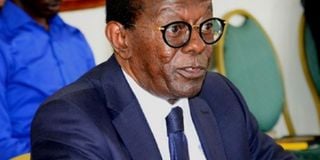Ugandans decided; no lessons learned

Author: Peter Mulira. PHOTO/FILE.
What you need to know:
- Mr Peter Mulira says: The mistake we make is trying to solve nationalities issue through political parties.
It is claimed by some scholars that the population of the African continent 125,000 years ago was one hundred and twenty- five thousand people, which multiplied to around four million people by the end of the stone age.
These ancestral Africans evolved and moved about the continent slowly populating it. Although initially it was difficult to stay in one place, the discovery of the metallurgy of iron enabled longer periods of settlement and this brought about significant increases in control over the physical environment.
As early populations grew in size, so did their reasons for dispersal. The group that moved became separate and distinct from any other group and, confronted with a new and unknown country, they had to apply their creativeness in new material situations.
To protect themselves against ecological and other hazards, people started living in clusters which provided them with security. As clusters grew bigger in size, these small societies began appointing chiefs in an effort to solve the problems of unity. In time, clusters evolved into clans and later some clans were organised into kingdoms.
The kingdom of Buganda, which has been at the centre of our controversies since Independence, evolved from a previous fiefdom known as Muwawa, which was established by five clans that originated from the Congo Kingdom.
Originally, each clan was autonomous of the others until new clans arrived from the north-east and it became necessary to have one overarching leader elected by the clans. The cultural leader who was elected was given the name of Sabataka. As the kingdom’s territory expanded, it became necessary to have a political head and Sabataka became the ruler known as the Kabaka.
At the onset of colonialism, the British dealt with the societies they found through agreements and conquest.
The case of Buganda Kingdom has created unresolved problems since Independence as many people tend to believe that the British gave her special treatment in the administration of the Uganda Protectorate.
The Potectorate was established under the Uganda Order-in-Council of August 11, 1902.
Under Section 6(b) of the Order, the Governor was empowered by proclamation to divide the territories consisting of Uganda into provinces and districts with such sub-divisions as “may be convenient for the purposes of administration describing the boundaries thereof and assigning names thereto.”
Pursuant to the above provision, Uganda was divided into four provinces and 13 districts. As for the people who made up a district, a number of clans with close similarities of language and culture, were bundled together to form what was called a tribe.
The tribe formed the district under a name chosen by the colonialists such as Bugisu, Lango, Acholi, Busoga, Kigezi and so on. The tribe was then given a local government based on the boundaries of the district.
Section 3 of the Buganda Agreement provided “The Kingdom of Buganda in the administration of the Uganda Protectorate, shall rank as a province of equal rank with any other provinces into which the Protectorate may be divided.
Towards Independence, Buganda insisted that she must maintain her status as a region in independent Uganda, but at their meeting in 1958, the secretaries general of district local governments rejected the idea, preferring the district to be the unit of local government.
Since that time, the issue has never been resolved. At the same time, nationalities which formed the colonial district have taken to demanding the creation of their own districts.
The mistake we have made is to always try to solve the issue of relationships of our nationalities through political parties. We should try other methods involving the people themselves.
Mr Mulira is a lawyer.
[email protected]




